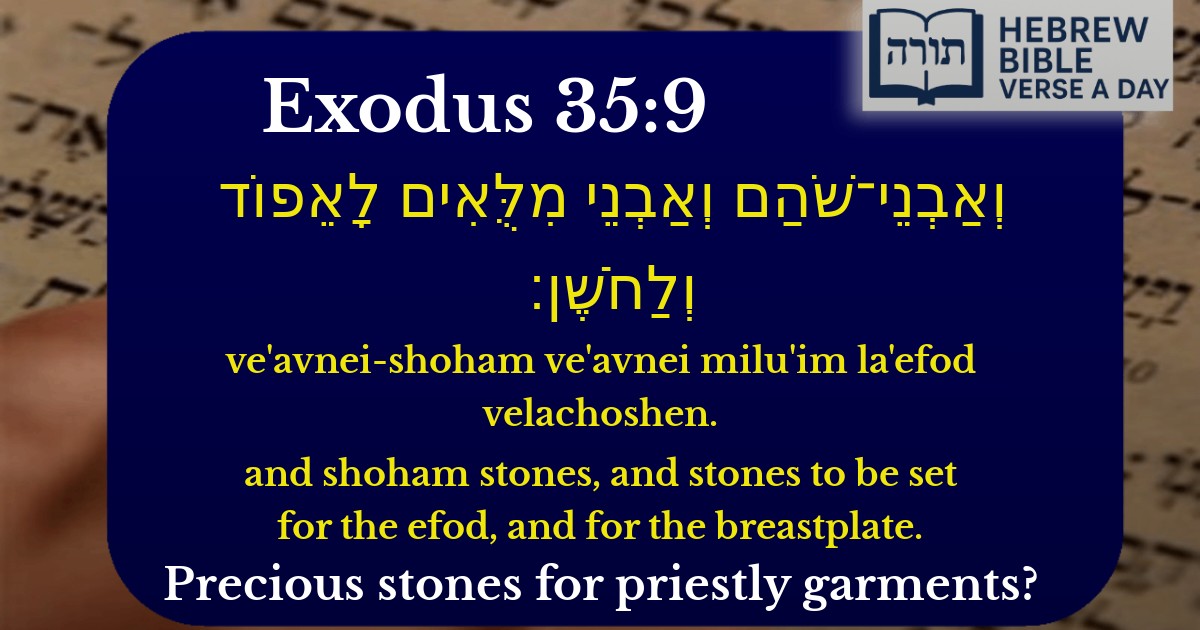Frequently Asked Questions
Q: What are the 'shoham stones' mentioned in Exodus 35:9?
A: The 'shoham stones' (אַבְנֵי־שֹׁהַם) are precious stones that were used in the High Priest's garments, specifically for the ephod and breastplate (חֹשֶׁן). According to Rashi and other commentators, the shoham stone is often identified as onyx, a beautiful black and white layered stone. These stones were engraved with the names of the tribes of Israel (Exodus 28:9-12).
Q: Why were special stones used for the ephod and breastplate?
A: The stones for the ephod and breastplate were chosen for their beauty and significance. The Talmud (Yoma 73b) explains that the breastplate (חֹשֶׁן) was used for divine communication, as the letters on the stones would light up to convey messages. Rambam (Hilchos Klei HaMikdash 9:7) teaches that these stones represented the spiritual connection between the Kohen Gadol (High Priest) and the tribes of Israel.
Q: What is the deeper meaning behind the stones in the High Priest's garments?
A: The Midrash (Shemos Rabbah 38:8) teaches that the stones symbolize the unity of the Jewish people. Each tribe had its unique role, yet together they formed a complete spiritual structure. The Zohar adds that the stones reflected divine light, representing how the Jewish people bring holiness into the world through their service to Hashem.
Q: How does the concept of precious stones in the Temple apply today?
A: While we no longer have the Temple or the High Priest's garments, the lesson remains relevant. The Mishnah in Avot (4:17) teaches that there are three crowns: the crown of Torah, the crown of priesthood, and the crown of kingship—but the crown of a good name surpasses them all. Just as the stones represented holiness in the Temple, our actions today should reflect spiritual beauty and dedication to Torah values.
Q: Were the stones in the breastplate the same as the stones in the ephod?
A: No, they were different. The ephod had two shoham stones (Exodus 28:9-12), each engraved with six names of the tribes of Israel. The breastplate (חֹשֶׁן) contained twelve different precious stones (Exodus 28:17-21), one for each tribe. Rashi explains that each stone in the breastplate had unique properties corresponding to the tribe it represented.


The Shoham Stones and Milu'im Stones
The verse mentions two types of stones: Shoham stones and Milu'im stones, which were used for the Efod (priestly apron) and the Choshen (breastplate). According to Rashi (Shemot 25:7), the Shoham stones refer to the two large stones placed on the shoulders of the Efod, engraved with the names of the twelve tribes of Israel. The Milu'im stones, on the other hand, were the twelve precious stones set into the Choshen, each representing one of the tribes.
Symbolism of the Stones
The Midrash Tanchuma (Tetzaveh 12) explains that the stones on the Efod and Choshen served as a constant reminder before Hashem of the righteousness of the tribes of Israel. The Rambam (Hilchos Klei HaMikdash 9:7) elaborates that these stones were not merely decorative but had a spiritual function, serving as a conduit for divine communication (through the Urim v'Tumim).
The Shoham Stones on the Efod
The Milu'im Stones on the Choshen